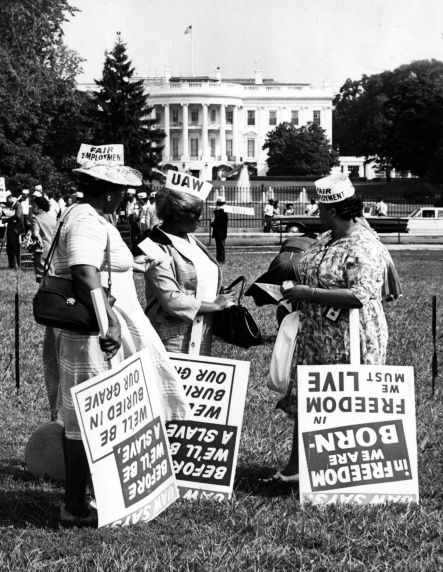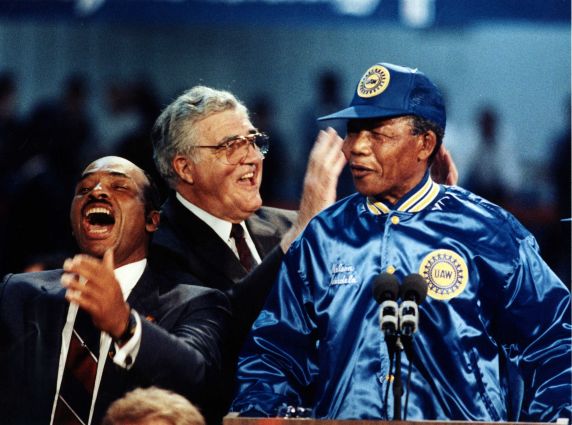African Americans and the UAW
- African American labor union members
- African Americans
- African Americans--Michigan--Detroit--History--20th century
- African labor leaders
- Anti-apartheid movements
- Automobile industry workers
- Bieber, Owen
- Civil rights--America
- Coalition of Black Trade Unionists (U.S.)
- Crockett, George W.
- Desegregation
- Desegregation
- Detroit (Mich.)
- Detroit--politics and government
- Detroit--race relations
- Dodge Revolutionary Union Movement
- Ford Motor Company
- Ford Rouge Plant
- Fraser, Douglas A. (Douglas Andrew), 1916-2008
- Integration
- Labor
- Lucy, William
- Mandela, Nelson, 1918-2013
- Michigan--History
- Race relations
- Reuther, Walter, 1907-1970
- Sheffield, Horace
- UAW
- UAW
- UAW Ford Local 600
- Walter P. Reuther Library
- Woodcock, Leonard
- Young, Coleman A.
The Reuther Library celebrates African American History Month with a brief review of the important role that African Americans have played in the formation and growth of the United Automobile Workers of America (UAW), one of the most powerful unions in American history, and the influence of black UAW members within the polity of Detroit.
In 2012, black workers had a higher union membership rate (13.4 percent) than white workers (11.1 percent). This was not always the case. A hundred years ago, African Americans were welcomed as members by only a few established labor organizations. Most unions, especially those formed around a particular craft, discriminated against African Americans, much like society at-large. A few unions, such as the United Mine Workers (UMW), did have constitutions that forbid discrimination against African Americans in the 1890s (although at that time the UMW was a staunch opponent of Asian immigrants, who it saw as low-wage rivals for jobs). Another early exception was when A. Phillip Randolph organized the Brotherhood of Sleeping Car Porters in 1925 — most porters in the heyday of travel by train were black — the first organization led by black workers to receive a charter from the American Federation of Labor. Randolph became its first president, and one of the most influential labor leaders and civil rights leaders in history. It was not until the 1960s and 1970s, however, that the majority of unions fully integrated black workers as members. During this era, African Americans slowly began to be elected to leadership positions at the local and regional levels, and in a few cases, held national union offices. For example, the United Automobile Workers’ first black International Executive Board member was Nelson Jack Edwards in 1964. For another, William Lucy became Secretary-Treasurer of the American Federation of State, County and Municipal Employees (ASFCME) in 1972, and was the highest ranking African American labor leader in America until his retirement in 2010.
Information on Africans Americans in the UAW and in the automotive industry can be found in the voluminous historical records of the UAW held by the Reuther Library. Although the UAW was established as a union open to all, it took some years to fully implement non-discriminatory policies within the union as well as on the factory floor. The UAW Fair Practices and Anti-Discrimination Department Records, which later became the UAW Civil Rights department, is an important collection that documents this longitudinal process. The UAW was also a powerful and crucial supporter of the national Civil Rights movement — in particular, the work of Martin Luther King, Jr. Information for all of the above subjects can be found in the files of the UAW President’s Office for Walter Reuther (1946-1970), Leonard Woodcock (1970-1977), Douglas Fraser (1977-1983), and Owen Bieber (1983-1995). The Bieber Collection is especially interesting regarding Nelson Mandela and the anti-apartheid campaign. The UAW and, in particular, President Bieber, devoted a great deal of effort and financial support for the release of Mandela from prison. One of the first places Mandela visited upon his release was Local 600 in Dearborn, Michigan, to personally thank UAW members for their support.
There are personal collections that also document the rise of African Americans in the UAW. Moreover, especially in the metropolitan Detroit area, holding UAW local and regional offices was also a launching pad for African American political leaders. Horace Sheffield was an International Representative for the UAW, as well as a nationally known civil rights leader. In particular, he was a leader in the Coalition of Black Trade Unionists and, most important, a founder of the Trade Union Leadership Council (TULC), an African American labor organization that became a significant force in Detroit politics. TULC played an important and powerful role in Detroit in the 1960s and 1970s. The organization became a player in the 1960 election of Mayor Jerome Cavanagh when the black vote in Detroit was the crucial factor in determining the city’s mayor. Robert “Buddy” Battle III was an early African American leader at UAW Local 600. This local, which services Ford Motor Company’s famous Rouge River industrial complex, was, until recently, the largest and most powerful local union within the UAW. Battle was an important local official and was elected UAW Region 1A director in 1976, a position he held until his retirement in 1983. Battle was also one of the founders of TULC and had a large presence in Detroit-area politics. The collection of Shelton Tappes has excellent materials on African American workers at UAW Local 600, and most important, the drive to organize Ford in 1941, in which Tappes was a prominent participant.
Although their papers largely document their political activities, Coleman A. Young and George Crockett began their careers in the UAW. Young was the first African American and most famous Mayor of Detroit (1974-1993). Crockett, who made his bones in the UAW, was the union’s general council and director of its Fair Employment Practices Committee (1944-1946). Crockett was later elected to the bench for the Recorder’s Court of Detroit in 1966.
 African American women stand in front of the White House during the 1963 March on Washington for Jobs and Freedom.
African American women stand in front of the White House during the 1963 March on Washington for Jobs and Freedom.
Race relations within auto factories are covered in several collections. The James Lindahl Papers hold useful information on race relations and civil rights at UAW Local 190, which was the local union for the Packard Motor Car Company in Detroit. Moreover, this local was the scene of a famous “hate strike” in 1943, when 25,000 workers left the plant to protest three African Americans being assigned to work alongside whites on the assembly line. Prior to this time, it was common to give African American autoworkers the least desirable jobs in the industry, if the company would even hire black employees. With the advent of the UAW, hiring and occupational placement for African Americans — men and women — slowly improved.
The UAW is a democratic union, and has always had internal dissidents and voices from the political left. The Ernest C. Dillard and Jessie M. Dillard Papers largely reflect the work of Ernie Dillard, who worked at UAW Local 15, which represented the Fleetwood Fisher Body Plant that made all the car bodies for Cadillac’s Clark Street Assembly Plant. He was an active member and was the first African American elected to a succession of leadership positions within the UAW. Dillard was also a prominent member of TULC, and a long-time activist in local politics and the civil rights movement. The Dodge Revolutionary Union Movement (DRUM) was an important African American dissident movement in the 1970s, and an important voice of opposition to the established union leadership. A record of its activities can be found in the Detroit Revolutionary Movements Records. The Dan Georgakas Papers also have a wealth of information on various issues regarding African American dissidents and other voices from black workers. For further details on collections related to other African Americans voices in the labor movement, see the excellent blog post, “Black Revolutionaries.”
For additional research angles into the topic of African Americans and the auto industry, consider the Peter Amann Papers, which are perhaps the best source for information on the Black Legion, a Ku Klux Klan-like vigilante organization that operated principally in Michigan and Ohio from 1925 through 1936, and infiltrated automobile factories in Detroit and elsewhere in the Midwest. Oral histories related to African Americans in the UAW are another excellent resource. Blacks in the Labor Movement and the UAW Oral History Collection are available in the Reuther Library Reading Room. There are also subject and biographical vertical files that provide information on individual black UAW members, as well as a wide range of related subjects. Finally, the Reuther Library also holds a complete collection of UAW publications such as the union’s official organ, Solidarity Magazine (and its predecessor, The United Automobile Worker), and a vast collection of photographic images and other objects for a visual view of African American autoworkers.
African American workers have made great strides within the UAW and the American labor movement since the early days of the automobile industry. The Reuther is home to the UAW’s official archives, and home to a vast number of collections with materials related to black autoworkers. This blog just cites the most prominent collections, and addresses only the tip of the research iceberg.
Michael O. Smith is the Archivist for the International Union, United Automobile, Aerospace and Agricultural Implement Workers of America (UAW) and Jewish Community Archives (JCA).
- mosmith's blog
- Login to post comments
- Printer-friendly version



 Reddit
Reddit Facebook
Facebook LinkedIn
LinkedIn